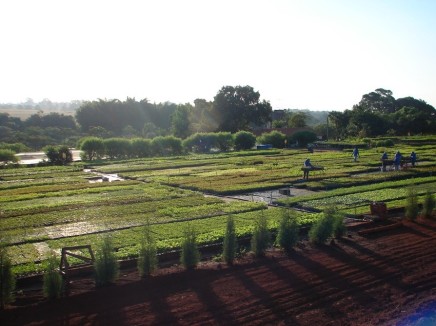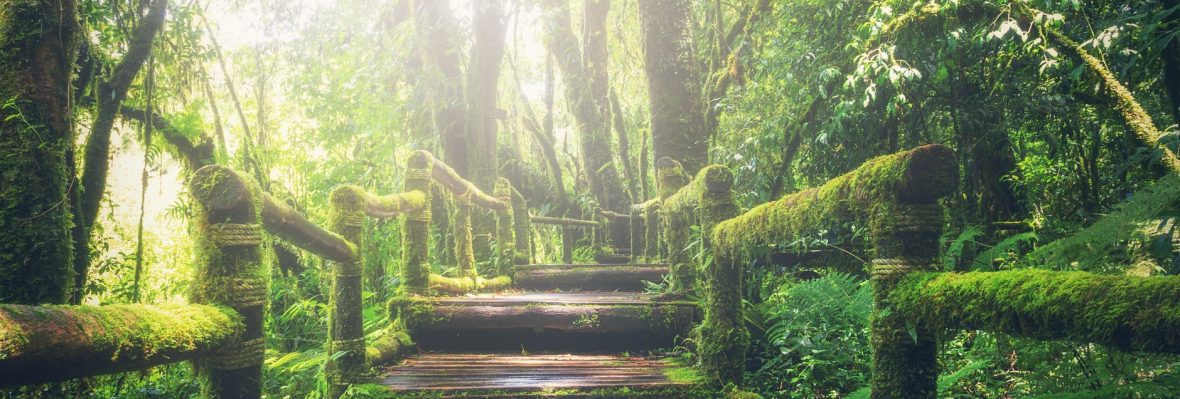How can scientific experiments help restore the vast tracks of degraded lands around the earth?
However mesmerizing Earthrise may be, strangely enough, we get a better yardstick for the health of our planet by looking back in the other direction.
The visible lunar surface during a full moon is approximately 19 million km2, an area similar in size to the staggering amount of degraded land back here on planet earth (2 billion hectares). If thirteen days later you decide to gaze up again you will see a waning crescent moon (ca. 18% illuminated), which is around 350 million hectares – equivalent to the amount of degraded land we are currently committed to try to restore by 2030 under The Bonn Challenge.

The good news is that governments and NGOs are currently committing to the restoration of degraded ecosystems on scales that would have been unimaginable when the shutter snapped on Earthrise half a century ago (e.g. AFR100, Trillion Trees). However, even with broad policy support and the substantial funding that underpins many of these enormous new projects, questions remain about whether the methods used to undertake these pledges are dynamic enough or have sufficient oversight to achieve their ambitious targets.
In our recent article published in Frontiers in Ecology and the Environment, we discuss the knowledge gaps that exist in current restoration practices. We also provide strategies to iteratively improve practices by systematically embedding experiments within restoration projects. We propose building networks of such sites and projects to assist in brokering the knowledge that will be gained from these experiments and call on industry stakeholders to develop acceptable industry standards for embedding experiments into restoration programs.
We highlight six key knowledge gaps that currently hinder restoration success at larger scales and identify how they could be addressed more effectively using interdisciplinary collaborations and embedding experiments during restoration. These gaps are:
- Defining desirable restoration outcomes – simple manipulations of planting treatments, species mixes targeted to ecosystem services, and even changes in fire regime are key focal points to consider for the design of embedded experiments in many biomes
- Integrating communities into restoration – using embedded experiments will engage communities and help facilitate participation. Embedded experiments can also help to evaluate the feasibility of seed production and propagation industries
- Providing finance for and support of restoration actions – testing species mixes allows investigation of carbon bio-sequestration and non‐timber forest products as revenue streams. Disseminating the knowledge about a biome allows wealthier member states to assist poorer states in developing embedded experimental infrastructure and improve restoration
- Implementing sustainable and progressive management of plant genetic resources – climate change poses a major threat to restoration success, and embedded experiments are already showing great promise in this important area
- Adopting emerging technologies – genomics is opening up new opportunities for restoration monitoring and assessment. The evidence gained from embedded experiments will encourage consistent practices that allow before–after control–impact experimental designs to investigate changes
- Improving restoration policies and governance structures – approaching restoration as a potentially sustainable economic activity promotes successful and efficient oversight

There are some good examples globally where the set up and design of restoration projects have specifically aimed to address some of these knowledge gaps.

At a regional scale, restoration of the Brazilian Atlantic forests effectively demonstrates the on-ground benefits of embedding experiments during restoration. For example, in the 1980s, exotic species were planted to stabilize sites, but this approach gave few biodiversity benefits. In the 1990s, species native to remnant forest patches in the region were used, which subsequently led to practices that sought to mimic and accelerate ecological succession in the early 2000s.
Early Atlantic forest restoration work led to a unified regional restoration alliance in 2009 called The Atlantic Forest Restoration Pact (AFRP), which has extended its primary ambition of restoring 1 million hectares by 2020 to an aspirational goal of 15 million ha by 2050. Due to the early inclusion of experiments and collaboration with social scientists, benefits were identified for communities and new cottage industries emerged (e.g. seed collection, nurseries, non-timber forest products). More recently, policy support and governance has helped to strengthen restoration of the Brazilian Atlantic forests.
Integrating, interpreting and extrapolating the results of embedded experiments like those used in the AFRP is a non-trivial task. Hence, networking restoration experiments, as opposed to simply embedding trials for project specific interventions, would be an optimal outcome for restoration. We, therefore, propose to use the lessons from allied disciplines to generate and network embedded experiments globally. To unify a networked approach to research infrastructure we also call on the restoration community to develop acceptable industry standards of experimental design.
We propose the cost of setting up embedded experiments and networking support in restoration does not have to be prohibitively expensive. We use the example of NutNet – a network set up to investigate nutrient cycling on a global scale – as a good example of a cooperative research network. Since inception in 2007 NutNet has used clear goals and well-designed experimental treatments to achieve its aims. We found that some key recommendations from NutNet were equally applicable to ecological restoration, and may be used to help frame future restoration networks.
The environmental and conservation movements that used banners like Earthrise to rally the masses early in the 1970s also became the genesis for modern restoration. Since that time ecological restoration projects have steadily increased in size from topical local treatments to regional or landscape programs. We believe that embedding experiments in restoration projects can bridge the key knowledge gaps of scaling up restoration. Using empirical evidence from these experiments to iteratively improve subsequent projects and creating networks to broker the knowledge more widely would therefore help tackle the unprecedented scale of restoration predicted in the 21st century.
Article written by Nick Gellie, Martin Breed and Andrew Lowe.
Paper: Nicholas JC Gellie, Martin F Breed, Peter E Mortimer, Rhett D Harrison, Jianchu Xu, and Andrew J Lowe (2018). Networked and embedded scientific experiments will improve restoration outcomes, Frontiers in Ecology and the Environment. Published online 8 May 2018. https://esajournals.onlinelibrary.wiley.com/doi/10.1002/fee.1810

